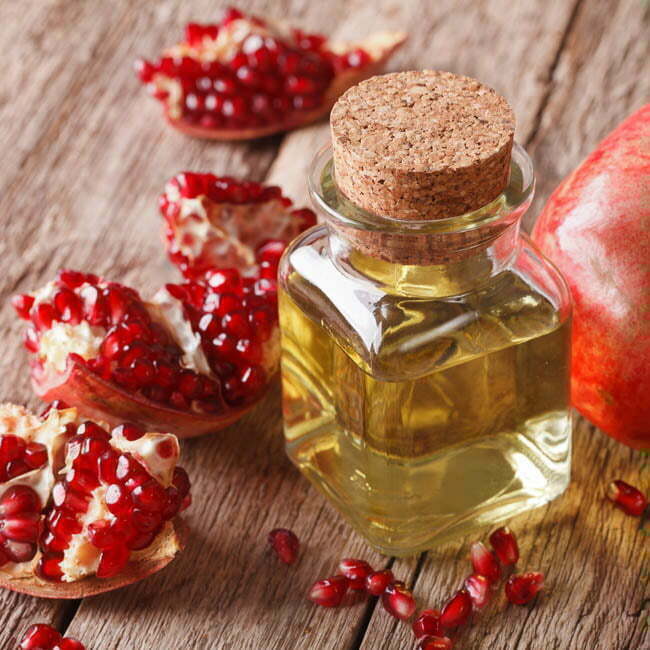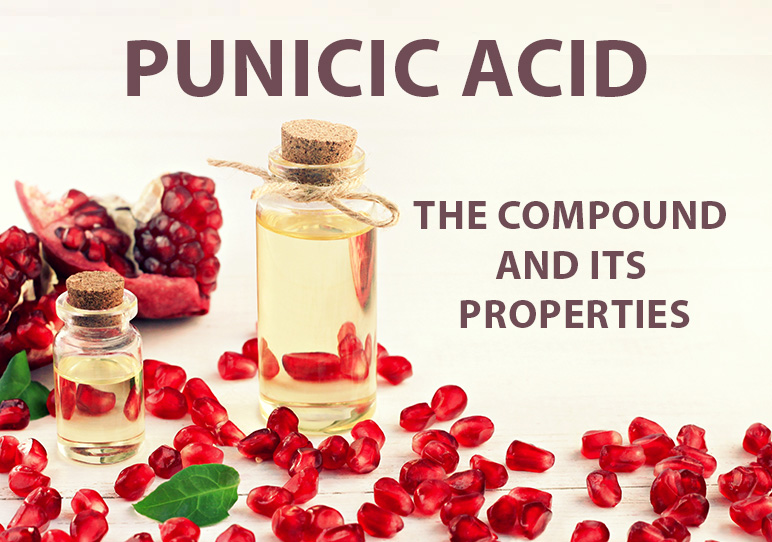Recently updated on: November 22nd, 2023
Polyunsaturated fatty acids (PUFAs), such as omega-3 and omega-6, are universally known for their health-promoting and multi-directional properties. However, of even more interest are their derivatives, which possess conjugated double bonds in their carbon chains that may be responsible for much higher health-benefitting potential. This group of substances include conjugated dienes of linoleic acid (conjugated linoleic acid – CLA) and conjugated trienes of linolenic acid (conjugated linolenic acid – ClnA), also called the “super-CLAs”. Punicic acid, belonging to the latter group, has been attracting growing interest among researchers.
What is punicic acid?
Punicic acid (IUPAC: 9Z,11E,13Z-octadeca-9,11,13-trienoic acid) is an isomer of conjugated α-linolenic acid with omega-5 polyunsaturated fatty acid, possessing three conjugated double bonds at positions cis-9, trans-11 and cis-13.
The primary source of punicic acid is pomegranate seed oil (Punica granatum), containing as much as 65-85% of the substance. Noteworthy, pomegranate seems to be a unique source of the compound. So far, only a few other plants have been found to contain it, from the genus Momordica (Momordia balsamica, M. charandia) and Trichosanthes (Trichosanthes anguina, T. kirilowii, T. bracteata), but with much lower contents of punicic acid.

Pomegranate seed oil
Food-and cosmetic-grade pomegranate seed oil is rich in punicic acid as well as oleic, linoleic, palmitic, and stearic acids. It also contains phytosterols and tocopherol (vitamin E).
Properties of punicic acid
Research of recent years indicates high potential of the super-CLA acids as having beneficial effect in the treatment and prevention of certain civilizational diseases. They possess not only antioxidant and anti-inflammatory properties, but also have proven anticancer, antidiabetic and antiatherosclerotic activity.
Punicic acid in the treatment of diabetes and obesity
Type 2 diabetes, also called insulin dependent diabetes, accounts for 90% of all diabetes cases across the world.
Research shows that regular consumption of pomegranate seed oil, with its high contents of punicic acid, slows down weight gain and reduces the risk of developing type 2 diabetes in mice fed high-fat diets. However, the underlying mechanism of this property is not fully understood.
It is most likely attributable not to a higher secretion of insulin or lowering of blood glucose levels, but rather to the property of making tissue cells more sensitive to insulin, by activating the nuclear peroxisome proliferator-activated receptors (PPARs) and inhibiting the TNF-α receptors. Moreover, the beneficial action of PPARs, which are lipid metabolism modulators, was also reflected in a better lipid profile, in particular showing a lower concentration of triglycerides in the liver.
Anticancer properties
Research conducted in vitro and in animal models shows cytotoxic properties of punicic acid.
In studies in vitro of breast cancer cell lines, punicic acid was an effective inhibitor of neoplastic cell proliferation and stimulated their apoptosis. The mechanism of this action is most likely associated with the acid’s properties causing peroxidation of lipids and activation of protein kinase C. Studies in rats, on the other hand, have shown beneficial activity of pomegranate seed oil in the treatment of colorectal and prostate cancer.
Other applications of punicic acid
Besides the aforementioned properties, punicic acid is a compound of strong antioxidant and anti-inflammatory activity. These multi-directional properties are of interest in the treatment of other diseases, as well.
For example, it has been proven to effectively mitigate digestive tract ailments, such as inflammatory bowel diseases and ulcerative colitis. Applied on the skin, it protects against free radicals, reactive oxygen species (ROS), as well as the harmful effects of UV radiation.
In animal studies, thanks to its strong antioxidant properties, punicic acid may be effective in amelioration of neurological conditions, by reducing demyelinating and neurodegenerative processes.
Literature:
- Aruna P., Venkataramanamma D., Singh A.K., Singh R.P., Health Benefits of Punicic Acid: A Review. Compr. Rev. Food Sci. Food Saf. 2016; 15: 16-27. https://doi.org/10.1111/1541-4337.12171
- Bedel H.A., Turgut N.T., Kurtoğlu A.U., Usta C., Effects of Nutraceutical Punicic Acid. Indian J. Pharm. Sci. 2017; 79 (3): 328-334. https://doi.org/10.4172/pharmaceutical-sciences.1000234
- Białek A., Teryks M., Tokarz A., Sprzężone trieny kwasu linolenowego (conjugated linolenic acid – CLnA, super CLA) – źródła i działanie biologiczne. Postepy Hig Med Dosw. 2014; 68: 1238-1250. https://doi.org/10.5604/17322693.1127881
- Binyamin O., Larush L., Frid K., Keller G., Friedman-Levi Y., Ovadia H., Abramsky O., Magdassi S., Gabizon R., Treatment of a multiple sclerosis animal model by a novel nanodrop formulation of a natural antioxidant. Int J Nanomedicine. 2015; 10: 7165-7174. https://doi.org/10.2147/IJN.S92704
- Koba K, Yanagita T., Chapter 108 – Potential Health Benefits of Pomegranate (Punica granatum) Seed Oil Containing Conjugated Linolenic Acid. [w:] Nuts and Seeds in Health and Disease Prevention, Academic Press, 2011. https://doi.org/10.1016/B978-0-12-375688-6.10108-2
- Shabbir M.A., Khan M.R., Saeed M., Pasha I., Khalil A.A., Siraj N., Punicic acid: A striking health substance to combat metabolic syndromes in humans. Lipids Health Dis. 2017; 16 (99) https://doi.org/10.1186/s12944-017-0489-3


